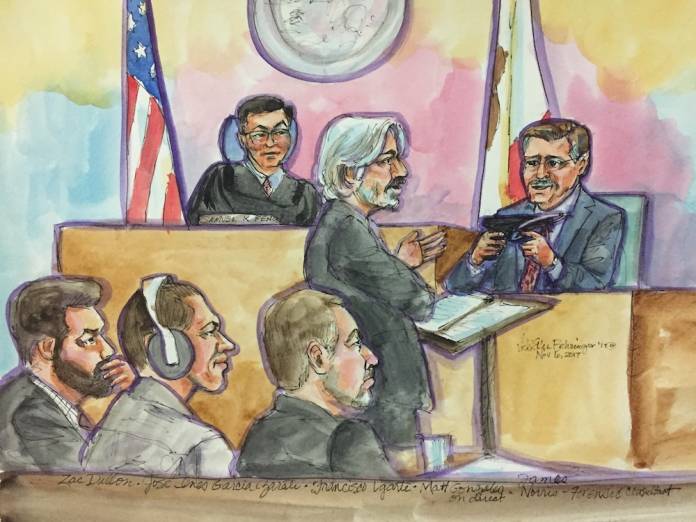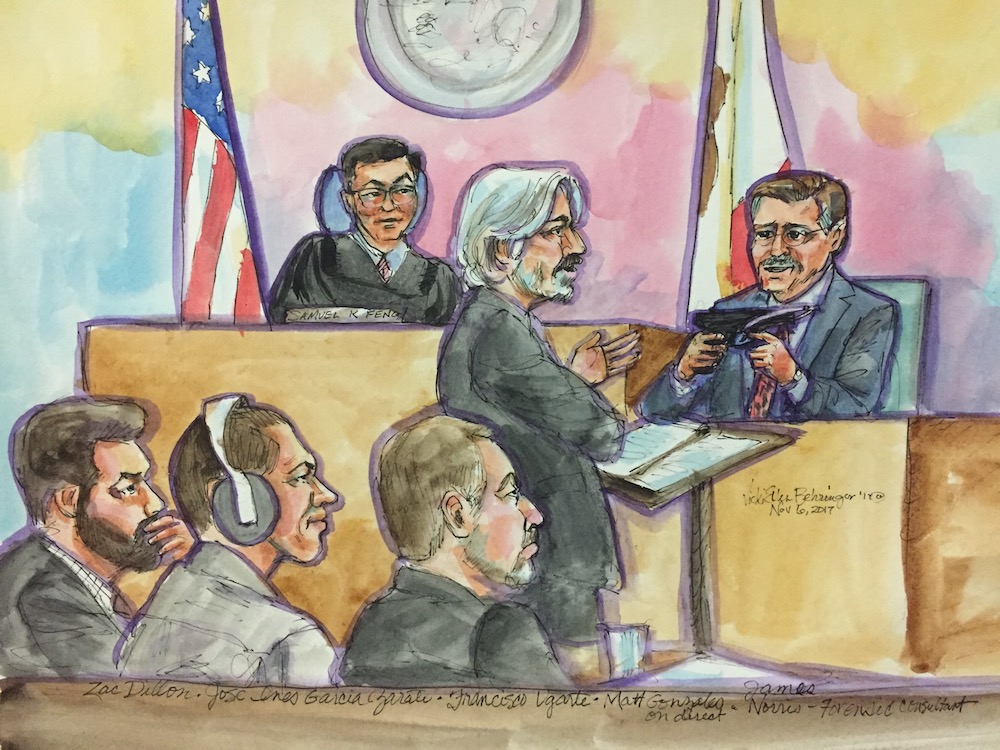
The bullet that killed Kate Steinle was probably fired from someone in a sitting position leaning forward, a defense firearms expert testified today in the Zarate Trial.
Although the judge would not allow James Norris, former director of forensic services for the San Francisco Police Department, to say that he thought the firearm discharge was an accident, the evidence he presented was consistent with that scenario.

Norris said that his analysis of the path of the bullet suggested that it was fired from between 1.5 and two feet from the ground. That’s completely inconsistent with the prosecution version of events: Prosecutor Diana Garcia and her key witness, who was not certified as an expert by the court, argued that Jose Ines Garcia Zarate intentionally aimed the gun in the direction of Steinle and pulled the trigger.
If Zarate had wanted to shoot someone, pointing the gun at the ground would make no sense, Norris said. And given that the gun, a Sig-Sauer semi-automatic, had a round in the chamber and seven more in the magazine, it’s unusual that he stopped firing after one round.
“At that distance, someone who wanted to shoot someone would keep shooting,” he said.
Norris described the gun as a weapon typically used by police and military personnel; it had no safety, and was advertised as ready to fire at any time.
The trigger pull was on the light side of handguns, at around 4 pounds in single-action mode, his testing showed. That’s about the amount of pressure on the trigger of “a squirt gun that little kids use,” he testified.
The trigger has to be moved about an eighth of an inch to fire, he said.
Help us save local journalism!
Every tax-deductible donation helps us grow to cover the issues that mean the most to our community. Become a 48 Hills Hero and support the only daily progressive news source in the Bay Area.
“Do you believe the Sig-Sauer 239 can accidentally discharge/” Gonzalez asked.
“Yes,” said Norris.
Q: “If somebody is handling the weapon and doesn’t mean to fire it, it can discharge?”
A: “Yes.”
Norris said he had worked on a case where an officer using this same firearm had drawn it and the trigger had bumped into a knob on his radio and gone off.
In fact, he said, the gun can fire if something hits the side of the trigger.
The prosecution’s main firearms witness, John Evans, insisted that “A human being held the firearm, pointed it in the direction of Ms. Steinle, pulled the trigger and fired the weapon, killing Ms. Steinle. This is the only way it could have happened.”
Evans said that the bullet skipped, but continued in the same straight-line direction after hitting the concrete pier.
But Evans was never certified as an expert witness, and Norris, who met that standard, directly challenged most of what Evans said.
When the projectile hit the concrete, he said, it would have changed direction – and it’s impossible to predict what path it might have taken. It could have curved, veered away from its original vector, moved to the left or the right … “this has been written about [in scientific literature] for years. When you shoot into concrete there is no way to predict where the bullet will go.”
Norris testified that he had read the report Evans wrote, and it didn’t change his opinion that it’s unlikely Zarate aimed the gun at Steinle. “The weapons seems to have been pointed down,” he said. “From that position, it would be very difficult to aim.”
He said that “no expert could say that it was a purposeful shot.”
The expert spent a fair amount of time talking about the trigonometry of the bullet: The angle that it hit the concrete, and the angle that it bounced off. The jury heard a lot about tangents and arc-tangents.
But the bottom line, he said, was that the gun was close to the ground at the time it discharged.
Gonzalez asked Norris about the gunshot residue on Zarate’s hand, and he explained that in his experience, the discovery of just one tiny particle of residue would not be enough to say that the person had fired a weapon. There are traces of GSR in police cars, on handcuffs, on the bodies of police officers … and since a gun discharges hundreds of these particles when it fires, the presence of more than one is generally needed to prove that a person fired the weapon, he said.
Norris said that if the gun was wrapped in a cloth or shirt at the time it discharged, that might explain why Zarate had only one particle of GSR on his hand.
On cross examination, Garcia tried to challenge Norris by saying that his statements today were inconsistent with his earlier testimony at the preliminary hearing – but that mostly fell flat. She pushed him on whether the gun could discharge without someone pulling the trigger, and he made clear that something – which could be someone’s finger or could be something else – might cause the gun to fire.
“We debunked the prosecution’s theory,” Francisco Ugarte, co-counsel with Gonzalez, told reporters.
Tomorrow the jury will see enhanced video evidence.

That was a dark sarcastic commentary on the fact that gun violence is epidemic in the US, and that most people have become desensitized. Cut the self righteous crap. Do YOU care about the 25 people killed in Texas over the weekend or the 50 killed in Las Vegas? If you care so much what are you doing to help solve the crisis ?
And it’s not really “video” in the sense it’s a continual stream — it’s the kind of security footage that is a series of stills taken from a stream.
The video isn’t proof of anything besides the fact there were others on the pier that day.
It certainly doesn’t disprove the prosecution’s case.
What a disturbingly sick thing to say — Kate Steinle was a human being who was killed while walking on a public street, and you want us to be _grateful_?
You just don’t give a hot damn about human life, do you?
A major study published on the front page of the New York Times suggests that the reason there are so many mass shootings in the United States is the fact that there are so many guns in proportion to the size of the population. How profound is that.
So in Zarate’s case people should probably be grateful. A gun gets into the hands of someone who shouldn’t have it and only one person is shot, not 25 or 50 or 100.
The video doesn’t show much; it is very grainy. Here is some of the video; there are people scattered about; the likelihood of a random shot hitting someone was quite low.
https://www.nbcbayarea.com/news/local/Kate-Steinle-Murder-Trial-Video-Appears-to-Show-Moment-of-Pier-Shooting-453196873.html
Remember, the story is that he was just unwrapping something that he didn’t even know was a gun. The shot could have gone anywhere. It could have gone straight up or down. It could have hit him in the stomach. It is interesting that the recoil from the unsecured gun didn’t injure him.
(no, I don’t believe his story for one second)
I didn’t watch the video. Were there lots of people around during the shooting? Was the bullet likely to hit someone no matter which way it went?